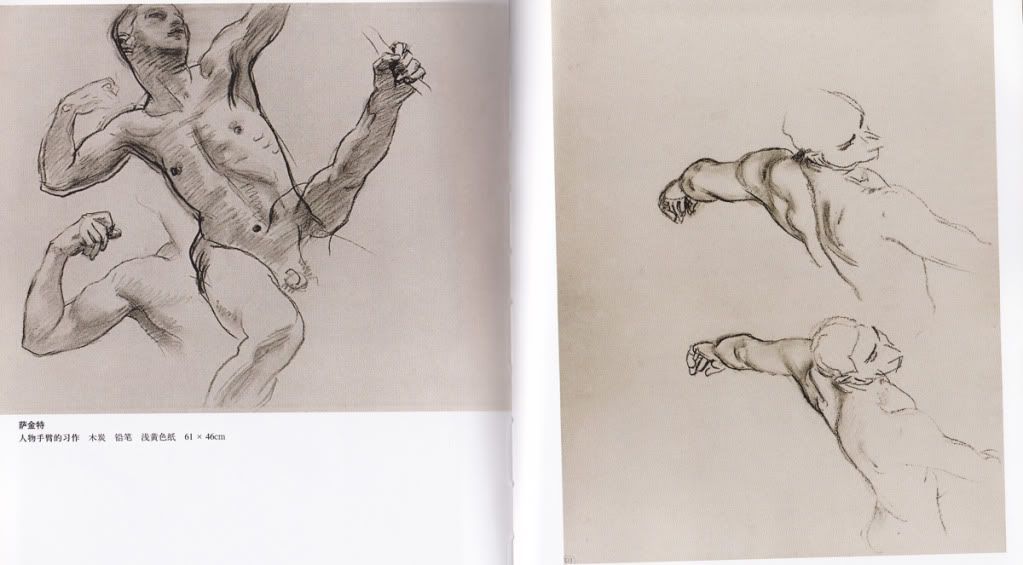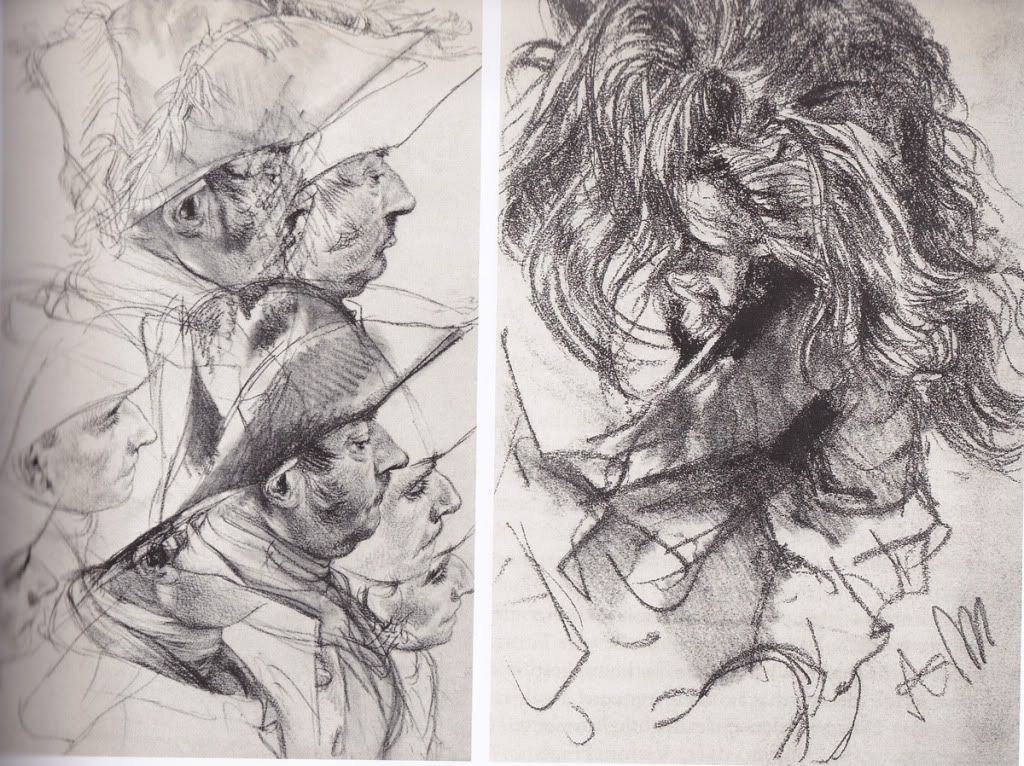| View previous topic :: View next topic |
| Author |
Topic : "Basic proportions in lifedrawing?? Pointers?" |
Returner
member
Member #
Joined: 01 Oct 2000
Posts: 350
Location: Sweden, Stockholm
|
 Posted: Tue Jun 30, 2009 9:36 am Posted: Tue Jun 30, 2009 9:36 am |
 |
 |
Took up lifedrawing a while ago especially drawing outside.
You gotta be loose in the beginning until u are secure with the basic proportions etc. Is/should that be all individual or is there some pointers to get faster at it? I get lost in the lines to much sometimes, all outlines and forget the form. And if the lines then are a little bit wrong I redo it to the point that the whole drawing starts to look like a dart table.
What to do?? I guess it's how to build up a drawing gradually with equal emphasis on shape and form I'm wondering about.
There's no substitute for drawing and not getting into the flow is probably my problem, over thinking instead of just drawing. Any thoughts?
Last edited by Returner on Tue Jun 30, 2009 10:34 am; edited 2 times in total |
|
| Back to top |
|
Nag
member
Member #
Joined: 25 Apr 2004
Posts: 287
Location: Iceland
|
 Posted: Tue Jun 30, 2009 10:22 am Posted: Tue Jun 30, 2009 10:22 am |
 |
 |
One thing that I like to do, is not to do lines at all in the beginning but only very loose marks. (Like the extreme proportions of shapes, the end of this, the corners of that etc.) I find it simplifies what you are working on and gives you an overall feel quickly. And it�s just marks, dots and occasional lines so its easy to erase and fix if you�re heading in the wrong direction.
Using big brushes/flat end of pencils also helps tons in thinking in big shapes and not falling into details. |
|
| Back to top |
|
Returner
member
Member #
Joined: 01 Oct 2000
Posts: 350
Location: Sweden, Stockholm
|
 Posted: Tue Jun 30, 2009 10:36 am Posted: Tue Jun 30, 2009 10:36 am |
 |
 |
| Thanks just the sort of tip I was after, I'll try that. |
|
| Back to top |
|
Tzan
member
Member #
Joined: 18 Apr 2003
Posts: 755
Location: Boston MA
|
 Posted: Tue Jun 30, 2009 11:46 am Posted: Tue Jun 30, 2009 11:46 am |
 |
 |
When I had some lifedrawing classes the teacher always did it this way:
1. do about (5) 30 second sketches.
2. some 1 min
3. some 2 min
4.some 5 min
5 (1) 10 min
6. (1) 15 min
7. (1) 30 min.
Or something like that.
The fast sketches are a warm up but also stop you from obsessing over detail. You have to work fast to get just basic lines down in 1 minute.
I also do what Nag said, layout some marks. We also used those charcoal pencils with the paper wrapping, this also prevents fine detail. |
|
| Back to top |
|
Returner
member
Member #
Joined: 01 Oct 2000
Posts: 350
Location: Sweden, Stockholm
|
 Posted: Wed Jul 01, 2009 4:48 am Posted: Wed Jul 01, 2009 4:48 am |
 |
 |
| Thanks tzan. |
|
| Back to top |
|
Cicinimo
member
Member #
Joined: 03 Mar 2001
Posts: 705
Location: Seattle
|
 Posted: Wed Jul 01, 2009 5:37 am Posted: Wed Jul 01, 2009 5:37 am |
 |
 |
What medium are you using? If you're forgetting form, you might try using some charcoal dust (you can buy jars of it) to lay down a middle ground at the start of your drawings. Then use an eraser to carve out the shapes of your light areas and build your forms from the inside out.
I'm glad there's a drawing thread. I scanned some of my favorites, hopefully you'll find these inspiring  : :
sargent

repin

menzel

drool
_________________
artpad.org
Last edited by Cicinimo on Thu Jul 02, 2009 9:51 am; edited 1 time in total |
|
| Back to top |
|
Affected
member
Member #
Joined: 22 Oct 1999
Posts: 1854
Location: Helsinki, Finland
|
 Posted: Wed Jul 01, 2009 12:15 pm Posted: Wed Jul 01, 2009 12:15 pm |
 |
 |
I don't know if there's any tip that one can give that will immediately make sense to you... My experience has been more that as I draw and learn more, I realize I've learned something someone told me to do ages ago, but couldn't apply then. One thing I'd recommend is doing a lot of fairly quick drawings, I at least find it forces me to learn to see the proportions more instinctively and to be economical with my linework, putting down only the essentials of the form. It helps if your model changes poses of course, so a life drawing class concentrating on croquis or at least 15-20 min poses would be beneficial.
Another thing, and this is probably very individual, is to try to think a little about what you think about when you draw. I've found that if I think of each line I draw as a contour in 3d space, I get a much stronger feel for the subject I'm drawing and the drawings tend to come out better. Probably others think differently, but I think finding out what your mind is like in this regard is helpful. |
|
| Back to top |
|
The Insane Lemur
member
Member #
Joined: 19 Oct 2003
Posts: 768
|
 Posted: Wed Jul 01, 2009 12:55 pm Posted: Wed Jul 01, 2009 12:55 pm |
 |
 |
i think affected nailed it as far as learning something someone said ages ago. I've just been reading vilppu's book, and it focuses on gesture-since even before form we see movement- I think that is extremely important. According to Hogarth in the book about clothing wrinkles he mentions the four movements- being extension, bending, rotation and twisting. In the gesture i try to get a sense of those 4 movements in the initial lines-then comes big interior form sense, then exterior form changes etc down to the little stuff... it really just needs like 80 years of daily drawing though  |
|
| Back to top |
|
notic
member
Member #
Joined: 09 Apr 2001
Posts: 441
Location: Sweden
|
 Posted: Thu Jul 02, 2009 4:09 am Posted: Thu Jul 02, 2009 4:09 am |
 |
 |
what Nag said is very worth listen to, i also learnt how to draw this way (watching the bob kato gnomon dvd: http://www.thegnomonworkshop.com/store/product/19/Drawing-the-Adult-Male-Head )
it made so much sense to me, and he's really a good teacher.
craig/spooge always talked about the importance of drawing, and he said that for him the gesture is the most important part of it, referring to vilppu |
|
| Back to top |
|
Jonas Heirwegh
junior member
Member #
Joined: 05 Nov 2009
Posts: 6
|
 Posted: Thu Nov 05, 2009 10:15 am Posted: Thu Nov 05, 2009 10:15 am |
 |
 |
Ok, you have to tell me where you found those repin drawings :d
I looked everywhere but couldnt find any full figure drawings by him...
Got any lifedrawings?
also what book did you got those Menzel's from?
What I find really interesting is there are no construction lines like you see in alot of today's life drawing (reilly, vilppu, fixler, etc...). Its a very direct approach and I like it that way, it keeps it fresh and full of life. Something that is really missing once you start going the analytical way imo. I see alot of students caught up in drawing construction lines, drawing without much looking at the model. They draw simplified forms for all bodyparts and while that is good to know it makes a drawing look very generic and missing all the nuances and characteristics each individual has.
Whats your view on this? |
|
| Back to top |
|
The Insane Lemur
member
Member #
Joined: 19 Oct 2003
Posts: 768
|
 Posted: Thu Nov 12, 2009 8:38 am Posted: Thu Nov 12, 2009 8:38 am |
 |
 |
i think the "construction lines" are something that is instructional-as to indicate what the forms are in a way so that forms can be understood and internalized by the students these figure drawing guys are teaching, I don't think they really heavily mark axises and stuff when they do personal artwork.
I think the drawings Cicinimo posted are very analytical and very well analyzed, not just a copy of shapes, these drawings really make sense and bring such character to the table! |
|
| Back to top |
|
Jonas Heirwegh
junior member
Member #
Joined: 05 Nov 2009
Posts: 6
|
 Posted: Thu Nov 12, 2009 9:21 am Posted: Thu Nov 12, 2009 9:21 am |
 |
 |
| The Insane Lemur wrote: |
i think the "construction lines" are something that is instructional-as to indicate what the forms are in a way so that forms can be understood and internalized by the students these figure drawing guys are teaching, I don't think they really heavily mark axises and stuff when they do personal artwork.
I think the drawings Cicinimo posted are very analytical and very well analyzed, not just a copy of shapes, these drawings really make sense and bring such character to the table! |
Yes but those analytical methods are something they only started doing in the 20th century.
I dont believe Repin did use alot of construction lines when he was a student. same for Sargent. They just did it without, unless a middleline once in a while but thats about it. Wether you want to or not but if you are trained very analytical and are used to use alot of construction lines it will shine through your work later on. If you look at alot of professional artists who are trained by the reilly method I cant help but notice how stiff it all looks when compared to these guys like Sargent, Repin and even contemporary artists who are trained with a more direct en free approach. The russian life drawings from the Repin Academy for example. Even Jamie Jones his stuff is a good example.
The drawings below are well analyzed but I think they are far from analytical. Read the chapter of Harold Speed's drawing book called "The academic and conventional approach". Anyway would like to hear Jamie his thoughts on this if he ever comes online again :p |
|
| Back to top |
|
|















